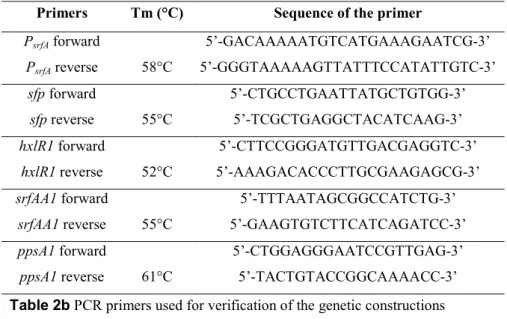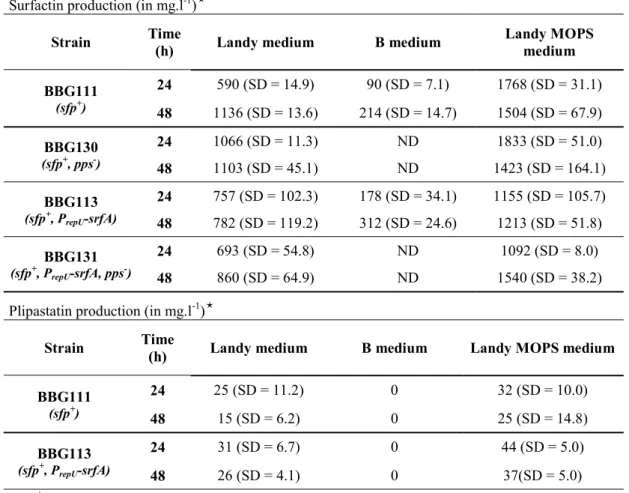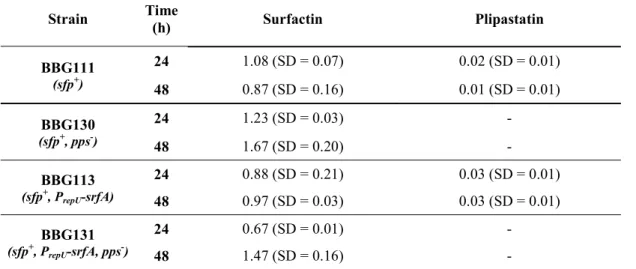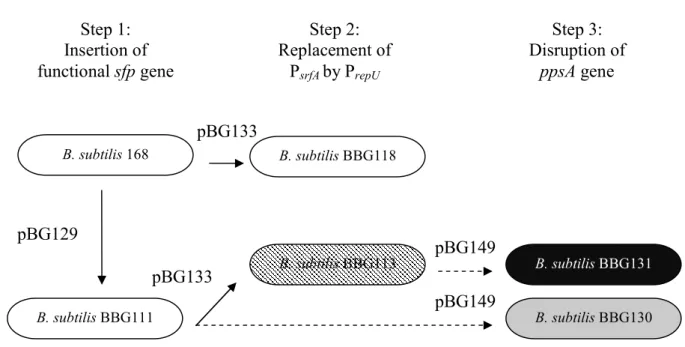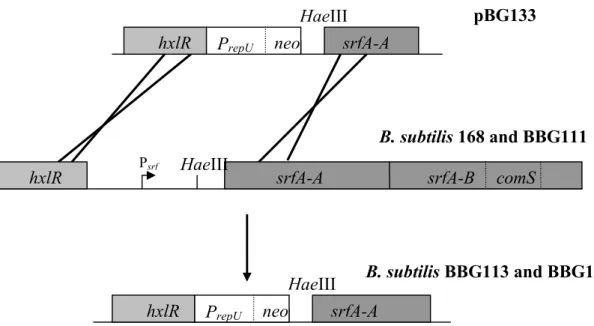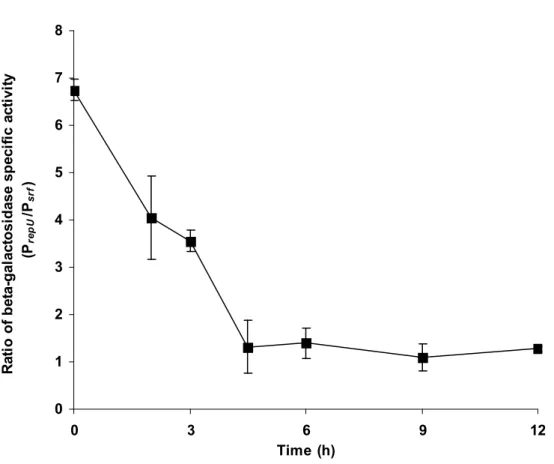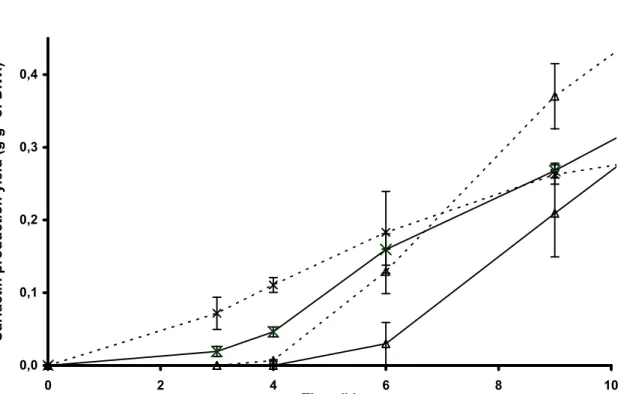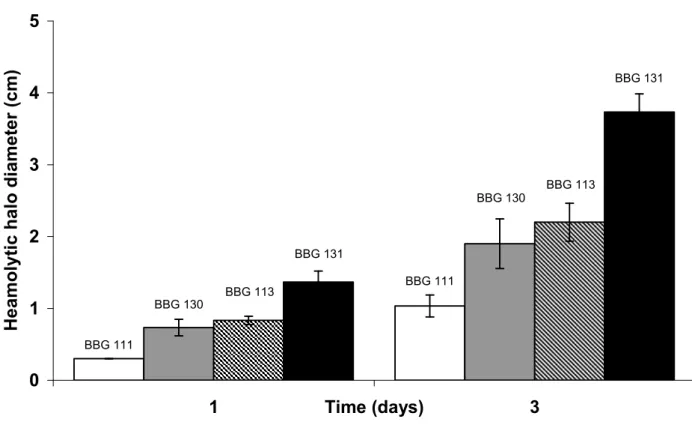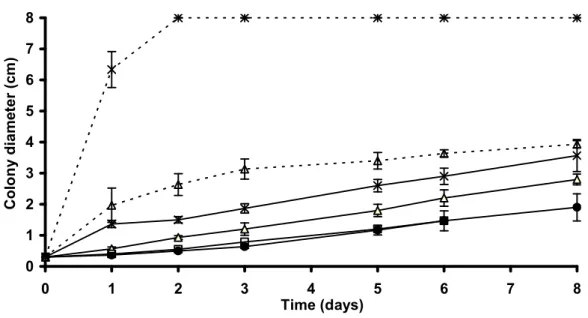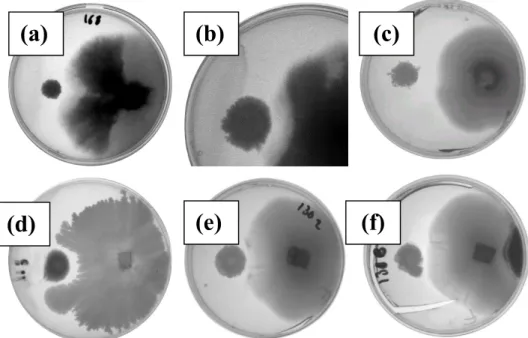HAL Id: hal-02939416
https://hal.archives-ouvertes.fr/hal-02939416
Submitted on 22 Sep 2020
HAL is a multi-disciplinary open access archive for the deposit and dissemination of sci-entific research documents, whether they are pub-lished or not. The documents may come from teaching and research institutions in France or abroad, or from public or private research centers.
L’archive ouverte pluridisciplinaire HAL, est destinée au dépôt et à la diffusion de documents scientifiques de niveau recherche, publiés ou non, émanant des établissements d’enseignement et de recherche français ou étrangers, des laboratoires publics ou privés.
Effect of pps disruption and constitutive expression of
srfA on surfactin productivity, spreading and
antagonistic properties of Bacillus subtilis 168
derivatives
François Coutte, Valérie Leclère, Max Béchet, Jean-Sebastien Guez, Didier
Lecouturier, Marlène Chollet-Imbert, Pascal Dhulster, Philippe Jacques
To cite this version:
François Coutte, Valérie Leclère, Max Béchet, Jean-Sebastien Guez, Didier Lecouturier, et al.. Effect of pps disruption and constitutive expression of srfA on surfactin productivity, spreading and antagonistic properties of Bacillus subtilis 168 derivatives. Journal of Applied Microbiology, Wiley, 2010, 109 (2), pp.480-491. �10.1111/j.1365-2672.2010.04683.x�. �hal-02939416�
Effect of pps disruption and constitutive expression of
srfA on surfactin productivity, spreading and antagonistic
properties of Bacillus subtilis 168 derivatives
Running title: Disruption of pps and constitutive expression of srfA in B. subtilis
François Coutte, Valérie Leclère, Max Béchet, Jean-Sébastien Guez, Didier
Lecouturier, Marlène Chollet-Imbert, Pascal Dhulster, Philippe Jacques*
Laboratoire de Procédés Biologiques, Génie Enzymatique et Microbien (ProBioGEM,
UPRES EA 1026), Polytech’Lille, IUT A, Université des Sciences et Technologies de
Lille, Avenue du Professeur Langevin, F-59655 Villeneuve d’Ascq Cedex, France
Phone: + 33 3 28 76 74 40 Fax: + 33 3 28 76 73 56.
Abstract
Aims : To analyse the effects of plipastatin operon disruption and constitutive expression of
surfactin operon in Bacillus subtilis 168 on surfactin productivity, in vitro invasive growth
and in vitro antagonism against fungi.
Methods and Results: The srfA native promoter was replaced by the constitutive promoter
PrepU in B. subtilis 168 after integration of a functional sfp gene. Moreover, the plipastatin
synthesis was further disrupted in the B. subtilis 168 derivatives. In liquid media, an earlier
and higher expression of PrepU, than that found with PsrfA, led to a specific surfactin production
5-fold higher after 6 hours of culture. On solid media, not only the in vitro invasive growth
and the haemolytic activity but also the in vitro antifungal activity of the constitutive strains
were improved as compared to the parental strain BBG111. As expected, the disruption of the
plipastatin operon strongly reduced in vitro antifungal properties but, interestingly, enhanced
specific surfactin production (1.47 g g-1 of biomass), spreading behaviour and haemolytic
activity of the strains.
Conclusion: This work demonstrates for the first time the interdependency of surfactin and
plipastatin regarding their biosynthesis as well as their influence on the biological activities of
the producing strain.
Significance and Impact of the Study: The constitutive overproduction of surfactin
enhances the invasive growth and the in vitro antagonistic activity of the mutant strain. Both
properties are known to play an important role in the biocontrol of plant diseases. Plipastatin
operon disruption increases the surfactin productivity of mutant strains. These mutants are
interesting for use in continuous bioprocesses for surfactin production or in bioremediation.
Keywords : Bacillus subtilis, surfactin, plipastatin, srfA operon, constitutive expression,
Introduction
The endospore-forming soil bacterium Bacillus subtilis produces up to three families of
lipopeptides, i.e., surfactins, iturins and plipastatins or fengycins (Bonmatin et al. 2003;
Ongena and Jacques 2008). These molecules are amphiphilic cyclic peptides with seven -amino acids linked to a hydroxy fatty acid for surfactins, seven --amino acids linked to a -amino fatty acid for iturins and ten -amino acids linked to a -hydroxy fatty acid for plipastatins. Surfactins are biosurfactant molecules with antiviral, antimycoplasmic, and
haemolytic activities (Vollenbroich et al. 1997; Peypoux et al. 1999; Deleu et al. 2003).It has
been shown that these lipopeptides are implicated in the medium colonization capacity of B.
subtilis, i.e, swarming, spreading or swimming behaviour, by favouring the gathering of the
cells into dendrites (Kearns and Losick 2003; Kinsinger et al. 2003; Julkowska et al. 2004;
Julkowska et al. 2005; Leclère et al. 2006; Hamze et al. 2009). They are also necessary for
the formation of pellicles at the air/liquid interface (Hofemeister et al. 2004; Chollet-Imbert et
al., 2009). Moreover, the production of surfactin is essential for biofilm formation and
colonization of plant roots, and surfactin formation may be an essential trait for effective B.
subtilis biocontrol strains (Bais et al. 2004).
Plipastatins or fengycins, produced after the end of the exponential growth phase, are strong
antifungal compounds and much less haemolytic than surfactin. These antifungal peptides
inhibit the growth of a large number of fungi, including Fusarium species (Jacques et al.
1999; Ongena and Jacques 2008). Moreover, B. subtilis lipopeptides were recently mostly
studied for their versatile activity in the biocontrol of a wide range of phytopathogens (Souto
et al. 2004; Leclère et al. 2005; Ongena and Jacques 2008). In addition to their direct
strain in terms of root colonization and also play a key role in the beneficial interaction with
plants by stimulating host defence mechanisms.
The production of surfactins is mediated by srfA, a 25 kb operon, which is composed
of four genes, srfA-A, srfA-B, srfA-C and srfA-D. The plipastatin operon (pps; 38 kb) consists
of five genes: ppsA, ppsB, ppsC, ppsD and ppsE. These two operons encode the
non-ribosomal peptide synthetase (NRPS) subunits, which catalyse the incorporation of the seven
amino acids into the surfactin and the ten amino acids into plipastatin (Thimon et al. 1992;
Marahiel et al. 1997; Peypoux et al. 1999; Du et al. 2001). The genetic locus sfp, encoding a
phosphopantetheine-transferase, is necessary for lipopeptide production, as it mediates the
conversion of the NRPS from the apo form to the holo form (Nakano et al. 1988; Quadri et al.
1998). Theproduction of surfactins is activated by a quorum-sensing mechanism at the end of
the exponential growth phase. The transcription of the srfA operon is directly activated by the
phosphorylated form of the factor ComA (ComA~P), the phosphorylation of which is
controlled by ComP (Cosby et al. 1998). Expression of srfA is mediated by the promoter PsrfA,
which was recently proved very strong in B. subtilis 168, compared with the PsrfA of B. subtilis
ATCC 6633 (Duitman et al. 2007). Modifications in the regulation of srfA directly altered the
expression of the competence regulatory gene comS, which is nested out of frame, within the
srfA-B gene, and thus the competence, the sporulation and the motility regulation pathways
(Hamoen et al. 1995). In fact, ComS causes the release of a competence-specific transcription
factor, ComK, from the ClpC-MecA proteolytic complex, resulting in ComK activation
(Ogura et al. 1999). ComK also activates the transcription of the late competence genes and
many genes involved in DNA cleavage, transformability, motility, regulatory factor, arginine
biosynthesis and transport [studied through microarray analyses (Berka et al. 2002; Hamoen
et al. 2002; Ogura et al. 2002), and reviewed by Hamoen et al. (2003)]. This description gives
In this study, genetic modifications of B. subtilis 168, whose genome is completely
sequenced (Kunst et al. 1997), were carried out. The native promoter driving the srfA operon
was replaced by a constitutive one PrepU.Then the plipastatin synthesis was disrupted in the
different mutant strains by interruption of the ppsA gene. The aim was to study the impact of
constitutive expression of the srfA operon, with and without the disruption of the plipastatin
operon, on the specific production of surfactin but also on phenotypic properties related to the
biocontrol abilities of the strains, such as in vitro medium colonization capacity or
antibacterial and antifungal activities. Positive and negative interactions of both lipopeptides
on these phenotypic properties are then discussed.
Materials and Methods
Bacterial strains, plasmids, and growth conditions
Strains of B. subtilis, Escherichia coli and plasmids used in this study are listed in Table
1. B. subtilis strains and E. coli JM109 were grown at 37°C with shaking at 130 rpm in
Luria-Bertani medium (LB) (Sambrook and Russel 2001). When required, various antibiotics were
added: ampicillin, sodium salt (Ap; Sigma, St. Louis, MO, U.S.A., 50 µg ml-1), neomycin
sulphate (Nm; Sigma, 30 µg ml-1), spectinomycin dihydrochloride (Spc; Sigma, 100 µg ml-1)
and chloramphenicol (Cm; Sigma, 5 µg ml-1). For all the B. subtilis 168 derivatives,
tryptophan was added at a concentration of 16 mg l-1, except in LB medium. The optical
density was measured at 600 nm to follow the biomass evolution (OD600nm) with an Uvikon
940 spectrophotometer (Kontron Instruments, Plaisir, France). Total biomass was determined
5 ml of culture sample were centrifuged for 10 min at 13,000 g, and the pellet was washed once with distilled water. The washed pellet was resuspended in 10 ml of distilled water and
dried on small pre-weighed aluminium dishes for 48 h at 105°C.
Molecular biology procedures
Total genomic DNA samples were purified from B. subtilis strains 168 and ATCC 21332
using the genomic tips 20/G together with the corresponding buffers purchased from Qiagen
(Hilden, Germany). Plasmid DNA samples were prepared from E. coli using either the
Miniprep Spin or Maxiprep kits (Qiagen). Screening for hybrid plasmids within various E.coli
transformants was carried out following the “boiling” procedure of Holmes and Quigley
(1981). Restriction endonucleases digestions (from Fermentas GMBH, St-Leon-Rot,
Germany), ligations and transformations of E. coli by the CaCl2 heat shock, were carried out
according to standard procedures (Sambrook and Russel 2001). B. subtilis 168 was
transformed either by natural competence (Sambrook and Russel 2001) or by electroporation
as previously described (Leclère et al. 2005). For PCR amplification, the primers (listed in
Table 2a) were designed according to the published sequence of the genome of strain 168
(PubMed Gene NC_000964.2), and supplied by Eurogentec (Angers, France). All the
PCR-generated cassettes used in this study were purified from 1% agarose gels using the QIAquick
Strain construction
The following genetic modifications of B. subtilis 168 were carried out:
-PsrfA and PrepU promoters lacZ fusions were introduced into amyE locus.
-An Sfp+ mutant was generated by complementation of the defective sfp0 allele with a
wild type copy, inserted ectopically in amyE by homologous recombination.
-The PsrfA promoter was replaced by the PrepU one in the wild-type and in the Sfp+ mutant
by keeping a short sequence located upstream of the RBS site as described by Nakano et al.
(1991).
-The plipastatin operon was interrupted in the Sfp+ mutants harbouring the two different
promoters. A summary of these different modifications is shown in Fig. 1.
Modified strains were selected after plating on LB agar containing the required
antibiotics, followed by incubation at 37°C. The genetic modifications were verified by PCR
amplification with B. subtilis primers designed outside of the sequence of the plasmid tools
used for the homologous recombination (listed in Table 2b). In each modified strain, after the
insertion of a DNA fragment within the B. subtilis genome, a fragment of larger size was
observed, compared with the corresponding fragment obtained from the parental strains (data
not shown).
In order to insert the promoter PsrfA or PrepU with a lacZ fusion into B. subtilis 168 by
homologous recombination within the amyE locus, pDG1661 (Guéroult-Fleury et al. 1996)
was first digested by EcoRI. The
ε
PsrfA cassette was generated by PCR using the PsrfA forwardand reverse primers together with the Taq polymerase “Arrow” from MP Biomedicals
(Illkirch, France) and inserted into the pGEM-T Easy vector (Promega, Madison, U.S.A.). On
Shiga, Japan), into the EcoRI site of pDG1661. On the other hand, the PrepU-neo fragment
from the plasmid pBG133 was extracted by EcoRI and ligated into the EcoRI site of
pDG1661. These constructions named pBG145 and pBG148 were then used to transform B.
subtilis 168, leading to transformants named BBG127 and BBG128, respectively.
To restore lipopeptide production in B. subtilis 168, the sfp gene from B. subtilis
ATCC 21332 was inserted into the amyE locus by homologous recombination as
demonstrated earlier (Lee et al. 2005). The
ε
sfp cassette was generated by PCR using the sfp forward and reverse primers and inserted into pGEM-T Easy. Then theε
sfp cassette was digested by EcoRI and ligated into the EcoRI site of pDG1661. This construction namedpBG129 was then used to transform B. subtilis 168, giving rise to a transformant named
BBG111.
For the construction of the pBG106-derived plasmid (Leclère et al. 2005) dedicated to
srfA promoter exchange by homologous recombination, we proceeded as follows. To generate
BBG113 and BBG118, the region located between the end of the hxlR gene and the HaeIII
restriction site situated upstream from the RBS of the first gene of the srfA operon, was
replaced. The
ε
hxlR andε
HaeIII-srfAA cassettes were generated by PCR using the hxlR1 forward and reverse primers and srfAA1 forward and reverse primers and then inserted intopGEM-T Easy. After digestion by EcoRI, the
ε
HaeIII-srfAA cassette was ligated within the EcoRI sites of pBG106, generating pBG124. Theε
hxlR cassette was SalI and SphI double-digested and ligated into the corresponding sites of pBG106, giving rise to pBG127. ThenpBG124 and pBG127 were double-digested by SphI and BglII, and the longer fragment of
pBG124 containing
ε
HaeIII-srfAA was ligated within the shorter digested fragment from pBG127 containingε
hxlR and PrepU-neo, leading to pBG133. This plasmid was then used toobtain mutants by homologous recombination in B. subtilis 168 and BBG111 as shown on
Fig. 2. The construction of BBG113 was verified by sequencing the PrepU-neo-srfAA sequence
amplified by PCR using the PrepU-neo forward primer and the srfAA3 reverse primer (listed in
Table 2b).
For the construction of the plasmid designed to disrupt the production of plipastatin in
B. subtilis 168-derived strains by homologous recombination, the
ε
ppsA cassette was generated by PCR with the ppsA1 forward and ppsA1 reverse primers and inserted withinpGEM-T Easy, generating pBG146. Then the spc cassette from pDG1661 was digested by
NarI + XhoI and introduced into the corresponding sites of pDG146. This construction,
named pBG149, was then used to transform B. subtilis BGG111 and BBG113. The obtained
transformants were named BBG130 and BBG131, respectively.
Lipopeptide production
All B. subtilis strains were grown at 37°C with agitation at 130 rpm either in Landy’s
medium, Landy medium buffered with 0.1 M MOPS as described previously (Guez et al.
2008), or in B medium (Julkowska et al. 2004). For the preculture, a single colony from
overnight plate culture was inoculated into 50 ml of the culture medium and grown overnight
at 37°C with agitation at 300 rpm. A second preculture, in 50 ml of the culture medium, was
carried out under the same conditions and stopped before the end of exponential growth
phase. The cells were centrifuged 10 min at 5,000 g, washed with physiological water, and centrifuged again. Finally, the pellet was suspended in 100 ml of culture medium in 1 l
Erlenmeyer flask to inoculate at an OD600 close to 0.05. In all cases, three replicate flasks
Lipopeptide purification and identification
Cultures were centrifuged at 15 000 g for 15 min at 4°C. The lipopeptides were quantified in the supernatant and in a cell pellet after lysis. The cell pellet was lysed by speed
freezing, resuspension in a lysing solution (20 mM Tris-HCl pH 7.5, 0.2 M NaCl, 1 mM
EDTA, 5 mg ml-1 lysozyme, 5 mg ml-1 deoxyribonuclease and 2.5 mg ml-1 ribonuclease A;
enzymes were supplied by Sigma) and subjected to ultrasounds during three one-minute-runs
at 6 watts using an ultrasonic processor from Bioblock Scientific (Illkirch, France). The lysed
pellet was centrifuged at 15,000 g for 15 min at 4°C and the lipopeptides were extracted from the supernatant. Lipopeptide extraction on C-18 columns and purification by HPLC
were carried out as previously described (Leclère et al. 2005). Surfactin and plipastatin
families were separately analysed using the solvents acetonitrile/water/trifluoroacetic acid
(80:20:0.1, vol/vol/vol), and (45:55:0.1, vol/vol/vol) respectively. Purified surfactins used as
references were purchased from Sigma. Purified plipastatins were a kind gift from Dr. Magali
Deleu (Agricultural University of Gembloux, Belgium). Retention time and second
derivatives of UV-visible spectrum (Diode Array Waters PDA 996, Millenium Software) of
each peak were used to identify and quantify the eluted molecules.
-amylase and β-galactosidase assays
-amylase activity was detected by growing B. subtilis colonies overnight on LB plates containing 1% soluble starch and then staining the plates with a potassium iodide and iodine
solution.
To analyse the expression of native and constitutive promoters using lacZ fusion in B.
production, at an initial OD600 close to 0.05. 1 ml samples were withdrawn at regular intervals
for determination of optical density and β-galactosidase activity as previously described
(Miller 1972). In all cases, three replicate flasks were used for each strain and the experiment
was repeated twice.
In vitro medium colonization assays
To analyse the invasive properties of the strains, a single colony from overnight plate
culture was inoculated in 5 ml of LB medium and grown overnight at 37°C with agitation at
130 rpm. The culture was diluted to get an OD600 of about 0.1 and grown again until an OD600
of about 0.4 in the appropriate medium was obtained. Finally, this culture was diluted in the
appropriate medium to an OD600 of about 0.1. The appropriate medium corresponded to the
same medium that was used for the assays on agar plates. Three microliters of the latter
culture were placed on the center of agar plates. Plates containing exactly 25 ml of either LB
or B medium containing 7 g l-1 agar (Julkowska et al. 2004) were prepared 90 min before
final inoculation and dried open for 15 min in a laminar flow chamber. After inoculation, the
plates were left open for 10 min in a laminar flow chamber to dry the inoculum spots. The
colonization was monitored for eight days of incubation at 37°C. Each sample was tested
three times and a statistical analysis of the results is presented.
Evaluation of haemolytic activity
Broth cultures and plate preparation procedures were carried out in the same way as the
medium colonization assays. Plates containing 25 ml of either LB or Landy MOPS medium,
l-1 agar, were inoculated and incubated at 37°C. Haemolytic activity was checked after one
and three day(s) by the development of a clear halo surrounding the colony. In all cases, three
replicate plates were used for each strain on both media and the experiment was repeated
twice.
Evaluation of in vitro antimicrobial and antifungal activities
Antimicrobial activities of the wild-type and modified strains were tested on plate
bioassays against Staphylococcus aureus and Micrococcus luteus, previously grown overnight
in LB medium and diluted (10-3). Then 200 µl were inoculated in 4 ml of LB soft agar (7 g l
-1). This diluted cell suspension (representing 5*10-4 cells) was poured onto LB plates,
prepared 60 min before final inoculation, and allowed to solidify.
To test the antifungal activity, different B. subtilis strains were co-cultured with Fusarium
oxysporum on Potato-Dextrose Agar (PDA) medium (Biokar Diagnostics, Beauvais, France)
and incubated at 30°C. The same B. subtilis inoculum was achieved as for the medium
colonization assay, the OD600 of the inoculum spot being 0.2. After inoculation, the plates
were left open for 10 min in a laminar flow chamber to dry the 5 µl inoculum spots. The
antibacterial or antifungal activity was evaluated every day by the development of a growth
inhibition area around the colony. Plates were photographed using GelDoc apparatus
(Bio-Rad Laboratories, Hercules, CA, U.S.A). In all cases, three replicate plates were used for each
Results
Comparison of the promoter strength
In order to confirm that PrepU was a suitable promoter to obtain an early expression of srfA
in B. subtilis 168, its strength was compared to that of the natural promoter PsrfA during the
first 12 h of culture using lacZ fusions. Both fusions were inserted into the B. subtilis 168
chromosome by homologous recombination within the locus amyE and verified by PCR
amplification. As expected, the modified strains, named respectively BBG127 and BBG128,
no longer displayed amylase activity (data not shown), and were then compared for their
β-galactosidase production, in Landy medium buffered with 0.1 M MOPS, to monitor the
expression levels of both promoters (Fig. 3). An earlier expression of PrepU, which was four
times stronger than PsrfA after 3 h of culture was observed during the first phase of growth.
After 6 h of culture, the expressions of both promoters converged.
Genetic modifications of B. subtilis 168
B. subtilis strain 168 contains the surfactin (srf) and the plipastatin (pps) operons but is
unable to produce these lipopeptides because of the lack of a functional sfp gene (Sfp0)
(Nakano et al. 1988). To study the effect on surfactin synthesis of the constitutive expression
of srfA, genetic modifications were carried out (Fig. 1). First, a Sfp+ mutant, named BBG111,
was generated by homologous recombination, allowing the restoration of the synthesis of
lipopeptides by insertion of an efficient sfp gene originating from the B. subtilis strain ATCC
21332 into the locus amyE, as already demonstrated (Lee et al. 2005). This modified strain no
promoter of the srfA operon was effected with the constitutive one, PrepU, originating from the
staphylococcal plasmid pUB110. These modified strains were named BBG118 and BBG113,
respectively (Table 1). As shown in Fig. 2, in these strains, the recombination was carried out
upstream from the HaeIII restriction site, which is itself located at 140 pb upstream from the
RBS of srfA operon.
Finally, the plipastatin operon was disrupted in the different B. subtilis 168-derived strains,
generating BBG130 and BBG131.
The modified strains were further compared regarding to their physiological behaviour,
biological activities and lipopeptide production.
Lipopeptide production by the B. subtilis 168 derivatives
Surfactin production was monitored during two days of cell growth in shaken Erlenmeyer
flasks (Table 3, Fig. 4). Although the absolute level of surfactin was different for each
modified strain, analysis of lipopeptide production in different media similarly revealed a
higher production of surfactin with BBG111 and BBG113 after 48 h incubation in Landy
MOPS medium, i.e., 1.5 and 1.2 g l-1 (Table 3), respectively. In this culture medium, the
surfactin production is up to 20 times more important than in B medium. The constitutive
strain BBG113 produced slightly more plipastatin (44 mg l-1) than its parental strain BBG111.
As expected, the strains BBG130 and BBG131 did not synthesize plipastatin, but after 48 h of
culture, the surfactin yield was higher in both BBG130 and BBG131, than in their parental
strains (Table 4). Moreover, the quantification of lipopeptides in the cellular pellet did not
show the presence of high concentration of intracellular surfactin (data not shown).
The kinetics of surfactin yield in Landy MOPS medium, analysed during the exponential
constitutive strain (Fig. 4). The observed surfactin production for BBG113 was 5 times higher
than for BBG111 after 6 h of culture, BBG113 remaining better during the first 12 h of
culture. This result make the relationship between the early activation of the PrepU promoter in
the constitutive strain, highlighted by the experiment showed in the Figure 3, and the early
production of surfactin showed in the Figure 4.
Haemolytic activity
As surfactin is known to be a strong haemolytic compound (Peypoux et al. 1999), B.
subtilis 168 and its derivatives were cultivated at 37°C on Landy MOPS blood agar (Fig. 5)
and on LB blood agar (data not shown). The strains B. subtilis 168 and BBG118, which do
not produce any lipopeptide (Sfp0), showed no haemolytic activity (data not shown). For each
Sfp+ strain,haemolytic activity was similar on LB medium and Landy MOPS.The haemolytic
halo on both culture media was larger for all Sfp+ constitutive strains with a maximum value
of 3.9 cm, reached after three days for BBG131. Haemolytic activity of the constitutive strain
BBG113 was higher than that of BBG111. A very light halo around the BBG111 colony was
observed after one day. With BBG113, a similar halo to the one observed with BBG111 was
detected after the same delay but on most of the plate surface (Fig. 5). This observation was
also verified after two days more. Moreover, in all cases, the plipastatin disruption enhanced
the haemolytic activities of the strains BBG130 and BBG131 (Fig. 5).
In vitro invasive growth
Biosurfactants, such as surfactin, mediate surface translocation of bacterial cells by
B. subtilis 168-derived strains. The diameter of the colonies was evaluated regularly for eight
days (Fig. 6). Strain 168, which does not produce lipopeptides, showed a restricted
colonization of the medium, as did BBG118. The spreading area was larger for the strain
constitutively expressing the surfactin synthetase genes. A refringent halo, which is known to
facilitate the colonization by lowering the wettability of the medium, with the appearance of a
diffusion circle, was observed surrounding the lipopeptide-producing colonies of BBG111,
while it arose earlier for the constitutive strains. The development of the BBG113 colony was
twice as large as for BBG111 after two days of incubation and this ratio remained constant
during the following days. The strains BBG130 and BBG131, in which plipastatin production
was interrupted, presented a colonization capacity 5 to 8 times stronger than their respective
parental strains.
In vitro antimicrobial activities
Antibacterial activity was evaluated against M. luteus and S. aureus by direct
confrontation on plates as described in Material and Methods. No antibacterial activity was
found against M. luteus whatever the bacterial strain. An activity was observed against S.
aureus for all the B. subtilis 168-derived strains, BBG113 showing an activity slightly better
than BBG111 (data not shown).
To determine the respective role played by surfactin and plipastatin in the antifungal
activities of BBG111 and BBG113, their antagonistic activity in vitro against F. oxysporum
was compared to that obtained with their respective plipastatin non-producer derivatives
BBG130 and BBG131 (Fig. 7). A small adverse effect to F. oxysporum growth was observed
with strains B. subtilis 168 (a) and BBG118 (d), probably due to substrate competition or pH
by BBG111 (b) and BBG130 (e). However, a significant and reproducible antifungal activity
was observed when the surfactin synthetase gene expression was controlled by the
constitutive promoter in BBG113 (c). We observed a high growth inhibition of the fungi
when the surfactin synthetase expression was constitutive. This effect disappeared when the
plipastatin operon was disrupted in BBG131 (f).
Discussion
The native regulation of the srfA operon is complex, especially because it involves
quorum-sensing (Cosby et al. 1998). In this study, we have replaced the native promoter PsrfA
of B. subtilis 168 by a constitutive one in order to inactivate the natural regulation of the
surfactin operon and to check the influence of an early production of surfactin on different
phenotypic traits of the strain. This constitutive promoter governs the replication gene repU
from the S. aureus plasmid pUB110 and was previously used with success in B. subtilis to
increase the production of two other lipopeptides: iturin A (Tsuge et al. 2001) and
mycosubtilin (Leclère et al. 2005). In both cases, the authors observed respectively up to
3-fold and 15-3-fold more lipopeptides produced by the recombinant strains. Moreover, the
authors showed that the constitutive expression of mycosubtilin enhanced the biocontrol
activities of the strains (Leclère et al. 2005).
In this work, this promoter substitution led to a specific surfactin production 5-fold
higher after 6 hours or culture. In addition, the early production of surfactin confers to the
producing strain a clear advantage for the colonization of the medium. This early surfactin
production is involved in the reduction of the surface tension (Deleu et al. 2003) and
promotes the invasive behaviour of the strain. This was shown by the spreading experiments
demonstrated that the CMC of surfactin can be correlated to the concentration required to
obtain 50% haemolysis.
The low colonization capacity of BGG118, a strain able to overexpress srfA and thus
comS, but unable (Sfp0) to synthesize the lipopeptides, compared to BBG113, highlighted the
minor role played by comS in this phenomenon compared to the earlier surfactin production,
as reported in a recent study (Hamze et al. 2009). Otherwise, since their target has been
removed, the complete replacement of PsrfA could cause the accumulation within the cell of
other srfA expression regulators. These factors seem to be implicated in the colonization
capacity of B. subtilis 168 (Hamze et al. 2009).
In this study, we have also disrupted the plipastatin synthesis by interruption of the
ppsA gene. The resulting mutant strains were used to observe the influence on various
phenotypic traits of the synergies and antagonism between surfactin and plipastatin. The
production of surfactin, the haemolytic activity and the in vitro invasive growth of the strain
were increased when the plipastatin operon was interrupted. The colonization and haemolytic
capacities were especially drastically amplified in BBG131 where an early high level of
surfactin production was observed. Several common precursors like some -hydroxy fatty acid chains, as well as glutamic acid, are involved in the biosyntheses of surfactin and
plipastatin. Both lipopeptide biosyntheses also require high level of ATP for the activation of
the different amino acid residues incorporated in their peptide moiety. In addition, both NRPS
involved in the biosynthesis of these two lipopeptides need to be transformed from
apo-enzyme to holo-apo-enzyme by addition of a cofactor due to the phosphopantetheine-transferase
encoded by the sfp gene. The knockout of the plipastatin operon may redirect such precursors,
needs in ATP and Sfp activity to the single surfactin biosynthesis. On the other hand, the early
production of surfactin enhanced the biocontrol abilities of the strain related to the plipastatin
lipopeptides had already been clearly demonstrated for surfactin and iturin (Thimon et al.
1992; Souto et al. 2004; Leclère et al. 2005), but never mentioned for surfactin and
plipastatin. It is also possible that the early surfactin production improved the diffusion of
plipastatin thus amplifying the antifungal activity of the strain. The constitutive strain
BBG113 presented a higher in vitro antagonistic activity and a rapid colonization of the
medium and these properties hold out great promise for biocontrol or bioremediation.
Comparing the production of surfactin and plipastatin by several strains in different culture
media brought to light the strong influence of the culture conditions. The highest production
of lipopeptides was observed in Landy MOPS medium, with BBG111 and BBG131 for
surfactin (1.5 g l-1) and with BBG113 for plipastatin (44 mg l-1), highlighting the importance
in controlling the pH. This had already been clearly demonstrated for surfactin operon
expression (Cosby et al. 1998), but never mentioned for plipastatin biosynthesis.
Interestingly, controlling the pH also has a positive effect on surfactin production by BBG113
which is quorum-sensing independent. The B medium, which is used for spreading
experiments, was less well-suited for lipopeptide production than the Landy medium.
However, the lower amount of surfactin produced in the B medium, which is still
considerably higher than the critical micellar concentration of this lipopeptide (10 mg l-1), was
sufficient to allow a good invasive growth of the strains. The small differences between the
specific surfactin production of strains BBG113 and BBG111 (table 4) after 24 h or 48 h of
growth may result from the strong PsrfA activity in B. subtilis 168 after the end of the
exponential growth phase, as demonstrated in our study through lacZ fusions and in a recent
report (Duitman et al. 2007). The high surfactin yield of the strain BBG131 make it
worthwhile considering its use in production processes especially ones with total biomass
recycling as the modifications carried out on the synthesis of surfactin made it quorum
Acknowledgements
This work received financial supports from the Université des Sciences et Technologies
de Lille, the Région Nord-Pas-de-Calais, the Fonds Européen pour le Développement de la
Recherche and the Ministère de l’Enseignement et de la Recherche. The authors thank M.
Ould Ahmed, E. Hamon and T. Oury from ProBioGEM Laboratory for their technical
References
Bais, P. H., Fall, R. and Vivanco, J. M. (2004) Biocontrol of Bacillus subtilis against infection of Arabidopsis roots by Pseudomonas syringae is facilitated by biofilm formation and surfactin production. Plant Physiology 134, 307-319.
Berka, R. M., Hahn, J., Albano M., Draskovic, I., Persuh, M., Cui, X., Sloma, A., Widner, W., et al. (2002) Microarray analysis of the Bacillus subtilis K-state: genome-wide expression changes dependent on ComK. Mol Microbiol 43, 1331–1345.
Bonmatin, J. M., Laprévote, O. and Peypoux, F. (2003) Diversity among microbial cyclic lipopeptides: iturins and surfactins. Activity-structure relationships to design new bioactive agents. Comb Chem High Throughput Screen 6, 541-556.
Chollet-Imbert, M., Gancel, F., Slomianny, C. and Jacques, P. (2009) Differentiated pellicle organization and lipopeptide production in standing culture of Bacillus subtilis strains. Arch Microbiol 191, 63-71.
Cosby, W. M., Vollenbroich, D., Lee, O. H. and Zuber, P. (1998) Altered srf expression in Bacillus subtilis resulting from changes in culture pH is dependent on the Spo0K oligopeptide permease and the ComQX system of extracellular control. J Bacteriol 180, 1438-1445.
Deleu, M., Bouffioux, O., Razafindralambo, H., Paquot, M., Hbid, C., Thonart, P., Jacques, P. and Brasseur, R. (2003) Interaction of surfactin with membranes: a computational approach. Langmuir 19, 3377-3385.
Du, L. and Shen, B. (2001) Biosynthesis of hybrid peptide-polyketide natural products. Curr Opin Drug Discov Develop 4, 215-228.
Duitman, E. H., Wyczawski, D., Boven, L. G., Venema, G., Kuipers, O. P. and Hamoen, L. W. (2007) Novel methods for genetic transformation of natural Bacillus subtilis isolates used to study the regulation of the mycosubtilin and surfactin synthetases. Appl Environ Microbiol 73, 3490-3496.
Guéroult-Fleury, A., Frandsen, N. and Stragier, P. (1996) Plasmids for ectopic integration in Bacillus subtilis. Gene 180, 57-61.
Guez, J. S., Müller, C. H., Danzé, P. M., Büchs, J. and Jacques, P. (2008) Respiration activity monitoring system (RAMOS), an efficient tool to study the influence of the oxygen transfer rate on the synthesis of lipopeptide by Bacillus subtilis ATCC6633. J Biotechnol 134, 121-126.
Hamoen, L. W., Eshuis, H., Jongbloed, J., Venema, G. and van Sinderen, D. (1995) A small gene, designated comS, located within the coding region of the fourth amino acid-activation domain of srfA, is required for competence development in Bacillus subtilis. Mol Microbiol 15, 55-63.
Hamoen, L. W., Smits, W. K., de Jong, A., Holsappel, S. and Kuipers, O. P. (2002) Improving the predictive value of the competence transcription factor (ComK) binding site in Bacillus subtilis using a genomic approach. Nucl Acids Res 30, 5517-5528.
Hamoen, L. W., Venema, G. and Kuipers O. P. (2003) Controlling competence in Bacillus subtilis: shared use of regulators. Microbiology 149, 9–17.
Hamze, K., Julkowska, D., Autret, S., Hinc, K., Nagorska, K., Sokowska, A., Holland, B. and Séror, S. J. (2009) Identification of genes required for different stages of dendritic swarming in Bacillus subtilis, with a novel role for phrC. Microbiology 155, 398-412. Hofemeister, J., Conrad, B., Adler, B., Hofemeister, B., Feesche, J., Kucheryava, N.,
Steinborn, G., Franke, P. et al. (2004) Genetic analysis of the biosynthesis of non-ribosomal peptide- and polyketide-like antibiotics, iron uptake and biofilm formation by Bacillus subtilis A1/3. Mol Gen Genomics 272, 363-378.
Holmes, D. S. and Quigley, M. (1981) A rapid boiling method for the preparation of bacterial plasmids. Anal Biochem 114, 193-197.
Jacques, P., Hbid, C., Destain, J., Razafindralambo, H., Paquot, M., De Pauw, E. and Thonart, P. (1999) Optimization of biosurfactant lipopeptide production from Bacillus subtilis S499 Plackett-Burman design.Appl Biochem Biotechnol 77-79, 223-233.
Julkowska, D., Obuchowski, M., Holland, I. B. and Seror, S. J. (2004) Branched swarming patterns on a synthetic medium formed by wild-type Bacillus subtilis strain 3610: detection of different cellular morphologies and constellations of cells as the complex architecture develops. Microbiology 150, 1839-1849.
Julkowska, D., Obuchowski, M., Holland, I. B. and Seror, S. J. (2005) Comparative analysis of the development of swarming communities of Bacillus subtilis 168 and a natural wild type: critical effects of surfactin and the composition of the medium. J Bacteriol 187, 65-76.
Kearns, D. B. and Losick, R. (2003) Swarming motility in undomesticated Bacillus subtilis. Mol Microbiol 49, 581-590.
Kinsinger, R. F., Shirk, M. C. and Fall, R. (2003) Rapid surface motility in Bacillus subtilis is dependent on extracellular surfactin and potassium ion. J Bacteriol 185, 5627-5631. Kunst, F., Ogasawara, N., Moszer, I., Albertini, A. M., Alloni, G., Azevedo, V., Bertero, M.
G., Bessieres, P., Bolotin, A. et al. (1997) The complete genome sequence of the gram-positive bacterium Bacillus subtilis. Nature 390, 249-256.
Leclère, V., Béchet, M., Adam, A., Guez, J. S., Wathelet, B., Ongena, M., Thonart, P., Gancel, F., et al. (2005) Mycosubtilin overproduction by Bacillus subtilis BBG100 enhances the organism's antagonistic and biocontrol activities. Appl Environ Microbiol 71, 4577-4584.
Leclère, V., Marti, R., Béchet, M., Fickers, P. and Jacques, P. (2006) The lipopeptides mycosubtilin and surfactin enhance spreading of Bacillus subtilis strains by their surface-active properties. Arch Microbiol 186, 475-483.
Lee, Y. K., Kim, S. B., Park, C. S., Kim, J. G., Oh, H. M., Yoon, B. D. and Kim, H. S. (2005) Chromosomal integration of sfp gene in Bacillus subtilis to enhance bioavailability of hydrophobic liquids. Appl Microbiol Biotechnol 67, 789-794.
Marahiel, M. A., Stachelhaus, T. and Mootz, H. D. (1997) Modular peptide synthetases involved in nonribosomal peptide synthesis. Chem Rev 97, 2651-2674.
Miller, J. H. (1972) Experiments in molecular genetics. Cold Spring Harbor, NY: Cold Spring Harbor Laboratory.
Nakano, M. M., Marahiel, M. A. and Zuber, P. (1988) Identification of a genetic locus required for biosynthesis of the lipopeptide antibiotic surfactin in Bacillus subtilis. J Bacteriol 170, 5662-5668.
Nakano, M. M., Xia, L. A. and Zuber, P. (1991) Transcription initiation region of the srfA operon, which is controlled by the comP-comA signal transduction system in Bacillus subtilis. J Bacteriol 173, 5487-5493.
Ogura, M., Liu, L., LaCelle M., Nakano, M. M. and Zuber, P. (1999) Mutational analysis of ComS: evidence for the interaction of ComS and MecA in the regulation of competence development in Bacillus subtilis. Mol Microbiol 32, 799-812.
Ogura, M., Yamaguchi, M., Kobayashi, K., Ogasawara, N., Fujita, Y. and Tanaka, T. (2002) Whole-genome analysis of genes regulated by the Bacillus subtilis competence transcription factor ComK. J Bacteriol 184, 2344–2351.
Ongena, M. and Jacques, P. (2008) Bacillus lipopeptides: versatile weapons for plant disease biocontrol. Trends Microbiol 16, 115-125.
Peypoux, F., Bonmatin, J. M. and Wallach, J. (1999) Recent trends in the biochemistry of surfactin. Appl Microbiol Biotechnol 51, 553-563.
Quadri, L. E., Weinreb, P. H., Lei, M., Nakano, M. M., Zuber, P. and Walsh, C. T. (1998) Characterization of Sfp, a Bacillus subtilis phosphopantetheinyl transferase for peptidyl carrier protein domains in peptide synthetases. Biochemistry 37, 1585-1595.
Sambrook, J. and Russel, D.W. (2001) Molecular Cloning: A laboratory manual, 3rd ed. Cold Spring Harbor, NY: Cold Spring Harbor Laboratory.
Souto, G.I., Correa, O.S., Montecchia, M.S., Kerber, N.L., Pucheu, N.L., Bachur, M. and Garcia, A.F. (2004) Genetic and functional characterization of Bacillus sp. strain excreting surfactin and antifungal metabolites partially identified as iturin-like compounds. J Appl Microbiol 97, 1247-1256.
Thimon, L., Peypoux, F., Maget-Dana, R., Roux, B. and Michel, G. (1992) Interactions of bioactive lipopeptides, iturin A and surfactin from Bacillus subtilis. Biotechnol Appl Biochem 2, 144-151.
Tsuge, K., Akiyama, T. and Shoda, M. (2001) Cloning, sequencing, and characterization of the iturin A operon. J Bacteriol 183, 6265-6273.
Vollenbroich, D., Pauli, G., Ozel, M. and Vater, J. (1997) Antimycoplasma properties and application in cell culture of surfactin, a lipopeptide antibiotic from Bacillus subtilis. Appl Environ Microbiol 63, 44-49.
Tables
Apr, resistance to ampicillin; Nmr, resistance to neomycin; Cmr, resistance to chloramphenicol; Spcr,
resistance to spectinomycin. Table 1 Strains and plasmids used in this study
Strains or plasmids Genotype or plasmid description Reference or source
Bacterial strains Escherichia coli JM109 Bacillus subtilis 168 B. subtilis BBG111 B. subtilis BBG113 B. subtilis BBG118 B. subtilis BBG127 B. subtilis BBG128 B. subtilis BBG130 B. subtilis BBG131 B. subtilis ATCC 21332 Plasmids pGEM-T Easy pDG1661 pBG106 pBG124 pBG127 pBG129 pBG133 pBG145 pBG146 pBG148 pBG149
recA1, endA1, gyrA96, thi, hsdR17, supE44 lac-proAB) /
F’[traD36, proAB+, lacl
q, lacZM15]
trpC2
trpC2, amyE::sfp-cat
trpC2, amyE::sfp-cat, PrepU-neo::HaeIII-srfA
trpC2, PrepU-neo::HaeIII-srfA
trpC2, amyE::PsrfA-lacZ cat
trpC2, amyE::PrepU-neo-lacZ cat
trpC2, amyE::sfp-cat, ppsA::spc
trpC2, amyE::sfp-cat, PrepU-neo::HaeIII-srfA, ppsA::spc
Wild-type
Cloning vector, Apr
Integration vector, spoVG-lacZ Apr, Cmr, Spcr
PrepU-neo fragment, Apr, Nmr
1.1 kb EcoRI HaeIII-srfA-A fragment inserted in pBG106, Apr ,
Nmr
0.7 kb SalI-SphI hxlR fragment inserted in pBG106, Apr , Nmr
1.1 kb EcoRI sfp fragment inserted in pDG1661
BglII hxlR fragment from pBG127 ligated within
SphI-BglII HaeIII-srfA-A fragment from pBG124, Apr , Nmr
EcoRI PsrfA fragment ligated within EcoRI fragment from
pDG1661, Apr , Cmr, Spcr
6.5 kb ppsA PCR-generated fragment cloned into pGEM-T Easy, Apr
EcoRI fragment from pBG106 ligated within the EcoRI site of pDG1661, Apr , Nmr , Cmr , Spcr
XhoI spc fragment from pDG1661 ligated within NarI-XhoI sites of pBG146, Apr, Spcr
Promega, Madison, USA Lab stock
This study (derived from 168) This study (derived from BBG111) This study (derived from 168) This study (derived from 168) This study (derived from 168) This study (derived from BBG111) This study (derived from BBG113) Lab stock
Promega, Madison, USA (Guéroult-Fleury et al. 1996) (Leclère et al. 2005) This study This study This study This study This study This study This study This study
Table 2a PCR primers used for genetic constructions
Primers Tm (°C) Sequence of the primer
PsrfA forward PsrfA reverse 58°C 5’-GACAAAAATGTCATGAAAGAATCG-3’ 5’-GGGTAAAAAGTTATTTCCATATTGTC-3’ sfp forward sfp reverse 55°C 5’-CTGCCTGAATTATGCTGTGG-3’ 5’-TCGCTGAGGCTACATCAAG-3’ hxlR1 forward hxlR1 reverse 52°C 5’-CTTCCGGGATGTTGACGAGGTC-3’ 5’-AAAGACACCCTTGCGAAGAGCG-3’ srfAA1 forward srfAA1 reverse 55°C 5’-TTTAATAGCGGCCATCTG-3’ 5’-GAAGTGTCTTCATCAGATCC-3’ ppsA1 forward ppsA1 reverse 61°C 5’-CTGGAGGGAATCCGTTGAG-3’ 5’-TACTGTACCGGCAAAACC-3’ Table 2b PCR primers used for verification of the genetic constructions
amyE forward amyE reverse 60°C 5’-CTTCGGTATGTGATTGTGAAGC-3’ 5’-GCAGACAATATCAGCATCCTTG-3’ hxlR2 forward srfAA2 reverse 54°C 5’-CTGCGCCTTTAATCGTTGC-3’ 5’-CGTCATGTCCTTACGGTAGCTC-3’ PrepU-neo forward
srfAA3 reverse 60°C 5’-CGCGAATTCGATTAAGATTAGG-3’ 5’-TCCTTCATCCGGTCTTTGAC-3’ spc1 forward ppsA2 reverse 60°C 5’-TATATACGGTGAGTGGCTCAGG-3’ 5’-GATATGCTGCAGCTAAATCCTC-3’
Table 3 Lipopeptide production by BBG111 and its derivatives in different liquid media Surfactin production (in mg.l-1)
Strain Time (h) Landy medium B medium Landy MOPS medium
BBG111 (sfp+) 24 590 (SD = 14.9) 90 (SD = 7.1) 1768 (SD = 31.1) 48 1136 (SD = 13.6) 214 (SD = 14.7) 1504 (SD = 67.9) BBG130 (sfp+, pps-) 24 1066 (SD = 11.3) ND 1833 (SD = 51.0) 48 1103 (SD = 45.1) ND 1423 (SD = 164.1) BBG113 (sfp+, P repU-srfA) 24 757 (SD = 102.3) 178 (SD = 34.1) 1155 (SD = 105.7) 48 782 (SD = 119.2) 312 (SD = 24.6) 1213 (SD = 51.8) BBG131 (sfp+, P repU-srfA, pps-) 24 693 (SD = 54.8) ND 1092 (SD = 8.0) 48 860 (SD = 64.9) ND 1540 (SD = 38.2)
Plipastatin production (in mg.l-1)
Strain Time (h) Landy medium B medium Landy MOPS medium
BBG111 (sfp+) 24 25 (SD = 11.2) 0 32 (SD = 10.0) 48 15 (SD = 6.2) 0 25 (SD = 14.8) BBG113 (sfp+, P repU-srfA) 24 31 (SD = 6.7) 0 44 (SD = 5.0) 48 26 (SD = 4.1) 0 37(SD = 5.0)
Values are means of data from three experiments
Table 4 Lipopeptide production yield (in g.g-1 of D.W.) in Landy MOPS medium
Strain Time (h) Surfactin Plipastatin
BBG111 (sfp+) 24 1.08 (SD = 0.07) 0.02 (SD = 0.01) 48 0.87 (SD = 0.16) 0.01 (SD = 0.01) BBG130 (sfp+, pps-) 24 1.23 (SD = 0.03) - 48 1.67 (SD = 0.20) - BBG113 (sfp+, P repU-srfA) 24 0.88 (SD = 0.21) 0.03 (SD = 0.01) 48 0.97 (SD = 0.03) 0.03 (SD = 0.01) BBG131 (sfp+, P repU-srfA, pps-) 24 0.67 (SD = 0.01) - 48 1.47 (SD = 0.16) -
Values are means of data from three experiments
Figures and legends
Figure 1 Schematic representation of B. subtilis 168 genetic modifications carried out in this
study. The plasmids used for homologous recombination are noted on or beside the arrows. Step 3: Disruption of ppsA gene Step 2: Replacement of PsrfA by PrepU B. subtilis 168 B. subtilis BBG118 Step 1: Insertion of functional sfp gene pBG129 B. subtilis BBG113 B. subtilis BBG111 B. subtilis BBG131 B. subtilis BBG130 pBG133 pBG149 pBG149 pBG133
Figure 2 Schematic representation of PsrfA promoter replacement in B. subtilis 168 and
BBG111. The constitutive PrepU promoter was integrated by homologous recombination
through a double crossing-over to replace PsrfA. The replacement in BBG113 and BBG118
was situated upstream of the HaeIII restriction site of the srfA operon.
Psrf HaeIII
hxlR srfA-A srfA-B comS
B. subtilis 168 and BBG111 HaeIII
hxlR PrepU neo srfA-A
pBG133
B. subtilis BBG113 and BBG118 HaeIII
0 1 2 3 4 5 6 7 8 0 3 6 9 12 Time (h) R at io o f b et a-g al ac to si d as e sp ec if ic a ct iv it y (Pre p U /Ps rf )
Figure 3 Comparison of the expressions of PsrfA and PrepU promoters with lacZ fusions. B.
subtilis BBG127 (trpC2, amyE::PsrfA-lacZ cat) and BBG128 (trpC2, amyE::PrepU-neo-lacZ
cat) were grown in Landy MOPS medium at 37°C with agitation at 130 rpm. The
β-galactosidase specific activity was measured at regular intervals and the ratio between the two
0,0 0,1 0,2 0,3 0,4 0 2 4 6 8 10 Time (h) S u rf a ct in p ro d u ct io n y ie ld ( g g -1 o f D .W .)
Figure 4 Surfactin production yield by B. subtilis BBG111-derived strains cultured in Landy
MOPS medium at 37°C with shaking at 130 rpm. The production of surfactin was quantified
by HPLC from purified supernatants withdrawn at different times of incubation and divided
by the dry weight of biomass. Full lines: () BBG111 and (×) BBG113, Dotted lines for the
BBG 111 BBG 111 BBG 130 BBG 130 BBG 113 BBG 113 BBG 131 BBG 131 0 1 2 3 4 5 1 Time (days) 3 H e a m o ly ti c h a lo d ia m e te r (c m )
Figure 5 Haemolytic activity on Landy MOPS blood agar of B. subtilis BBG111-derived
strains. Three microliters of culture of each strain in exponential growth phase were placed
0 1 2 3 4 5 6 7 8 0 1 2 3 4 5 6 7 8 Time (days) C o lo n y d ia m et e r (c m )
Figure 6 Invasive behaviour of B. subtilis 168-derived strains. Strains in exponential growth
phase were inoculated as a single colony on 0.7% agar containing B medium at the center of
the plate with a standardized method then incubated at 37°C. The diameter of the colonies
was measured at regular intervals. Full lines: () B. subtilis 168, () BBG111, (×) BBG113
and () BBG118. Dotted lines for the derivatives that do not produce plipastatin: ()
Figure 7 Antifungal effect of B. subtilis 168 derivatives against F. oxysporum. Five
microliters of strain suspension in exponential growth phase were placed using a standardized
method (onto the left side of the plate) in front of the fungus (right side of the plate) on PDA
medium. The pictures were taken after 6 days of incubation at 30°C. (a) B. subtilis 168
(trpC2); (b) BBG111 (trpC2, amyE::sfp-cat); (c) BBG113 (trpC2, amyE::sfp-cat, PrepU
-neo::HaeIII-srfA); (d) BBG118 (trpC2, PrepU-neo::HaeIII-srfA); (e) BBG130 (trpC2,
amyE::sfp-cat, ppsA::spc); (f) BBG131 (trpC2, amyE::sfp-cat, PrepU-neo::HaeIII-srfA,
ppsA::spc).
